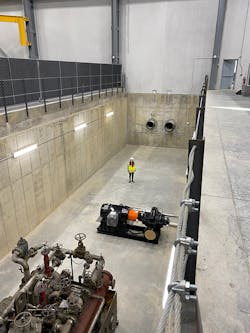Engineering and Motherhood: Finding That Delicate Balance
The idea of starting a family was so exciting for me, but I was already stressing about being a new mom that the constant thoughts of how this would affect my career trajectory in engineering was daunting.
Would I be passed up for a raise this year since I plan on taking time off? Would I fall behind learning a new design software system we are using? Would clients stop calling because they think I am preoccupied or unreliable?
These are only a small sample of challenges that were to come and, as I would learn, were completely out of my control.
I decided I needed to make a plan but had no idea where to start. So I took my RMF handbook home from the office and sat down at the kitchen table. The only information available in it about pregnancy was the short-term disability policy, but I wasn’t sure what steps I had to take. What forms were required to be filled out? I knew what my insurance covered for physicians and prescriptions, but what was my maternity coverage? My list of questions began.
Engineers are analytical and rely on facts. However, we also must be creative and solution-oriented. I knew that preparing for my pregnancy was just another engineering challenge as I was the first young female to get pregnant at our firm in several years. So my journey would be the test run, a guinea-pig, if you will. My first steps were to sit down with my husband and discuss what our future would look like. What amount of time for a maternity leave did we feel was right? Did I want to go back to work full-time or part-time? We wrote down all the items that were important to us and how we would make this work with our respective companies.
My next step was a conversation with my engineering supervisor.
As we all know, if you go to your manager with a challenge, you should always be prepared to present a solution or plan of action. I went in Monday morning and I asked my boss for a few minutes to discuss. Naturally, he was very excited to hear that we were starting a family. I walked him through my plan and let him know that I wanted to take three months maternity leave. Once those three months were up, I explained, I then planned to come back to work full-time. However, it was also important for me to continue breastfeeding. Therefore, I was going to need a private place to pump at work.
My boss, a family man, himself, understood the situation and was willing to work with me. He was grateful that I was honest about what I wanted, and that I had discussed what I needed from him and the firm. While he started making arrangements for a mother’s room with our office administrator, I prepared to tackle my next step: Human Resources.
Our HR department physically sits in our headquarters building in Baltimore, MD, while I am located in our Charleston, SC, office. So I had to call corporate and set up a meeting. I informed the head of HR that I was pregnant but was unsure of what to do next and needed a better understanding of our maternity leave policy.
It turns out that the short-term disability policy is 60% pay for six weeks. We were happily surprised when we found out that those payments are not taxed, so the payment was much closer to my full earnings than just 60%. I was instructed to call my short-term disability insurance company and let them know my due date and the day I anticipated starting maternity leave. I already knew that I wanted to take 12 weeks, so with the guidance of HR, I filled out the FMLA paperwork.
Many people had told me that my insurance may cover things for new mothers, such as a breast pump, but no one could tell me how to order it. I called my insurance company to get more information and they were a huge help. Employee handbooks are intentionally vague since information is constantly changing but the wealth of knowledge I received on the insurance call was very detailed.
I learned things like, how to order a breast pump and from which companies, which genetic testing was included with my coverage, as well as other maternity benefits such as extra dental cleanings. (Little did I know then that pregnancy wreaks havoc on your teeth!)
My day-to-day activities in the office also needed an adjustment. I knew the days behind the computer were going to be fine, but surveys on-site had to be drastically changed. It was no longer safe to crawl under pipes and climb up an unsteady ladder to inspect air handling units. I now needed someone from my office to assist me with measurements and data collection until my eighth month. Fortunately, my peers were very supportive, taking on extra work in the field, as need, to help.
During my last month, I stayed in the office and close to home. I reminded my clients and owners of my due date, maternity leave length, and made sure they had contact information for all team members in case they had any questions. I was shocked every time a client would ask me if I had plans to come back to work, and it happened a lot. It may be most industries or the Southern way of life, but I had no intention of slowing down my career.
The industry changes so often, that the software, equipment, codes and owners’ needs are constantly evolving. I wanted to make sure I was a part of those changes.
During my last trimester, I kept a running list of all current tasks that the team and I were working on. I made sure to update the list every Monday and kept it in a project folder for all team members to access. It was important to keep all parties up to date on tasks for a smooth transition into maternity leave as I didn’t want any outstanding items to slip through the cracks if I needed to go to the hospital earlier than expected.
Smooth Delivery, But New Questions
I was blessed to have a smooth labor and delivery and a healthy, happy baby girl! Between the sleepless nights and learning how to be a parent, maternity leave went by very quickly. When the six-week mark came, it dawned on me that if I had not taken the full three months, I would already be heading back to work. At that time, I was not feeling fully recovered and I was barely sleeping. So other than changing a diaper and knowing how to make scrambled eggs, anything more complex, like sizing an air-handling unit for work, would have been, well, difficult.
Towards the end of my maternity leave, the stress of going back to work was profound. The guilt I felt knowing others were going to raise my daughter weighed on me heavily; a feeling all working moms must have. And the nagging questions returned:
What if my firm realized I was no longer needed? What if I’m a step or two slower than I used to be? How will this affect my career moving forward? What is going to happen if I need to step out of a meeting or away from a site visit because of the need to pump? I was already stressing about every situation before even returning to the office!
My first day back was filled with worry, so it was hard to focus on work. Although it was great to get dressed up, see my coworkers and have adult conversations again, I still felt a bit overwhelmed. It was not only my child’s first day away from me, but also her first day at daycare. Did she need her diaper changed? Were they helping her? I hope she’s not crying!
Every time someone asked me how I was doing, I cried! But you know what, that’s okay. Trying to figure out our new daily routine at home took us about two weeks. My evenings were no longer filled with binge-watching shows and my mornings were no longer about working out and enjoying a cup of coffee.
Our schedules completely changed.
My husband and I worked together to determine a routine that worked best for both of us. He takes the morning shift and sends me photos to get me through the early mornings at the office. Fortunately, my company has flex hours, so I can start the day earlier and then leave a little earlier. And now my evenings are filled with prepping baby bottles, blending baby food, making my lunch and preparing for tomorrow’s dinner.
At the office, I pump between meetings in the mother’s room and in the car, and on my way to job sites. I’m so grateful that my coworkers are understanding when I need to leave by 4 pm to pick up my daughter from daycare. By the time we drive home from daycare and rotate the laundry, it’s time to prep dinner. While my husband cooks, we catch up for the day and I nurse. Ideally, we all sit down and attempt to eat together. But often we only have 10 minutes before there is a meltdown and we need to start our bedtime routine.
By the time we give our daughter a bath, put her in pajamas and read her a bedtime story, it’s close to 7:30pm. After that, it’s back to work at the kitchen table.
Communication is key. Work with your supervisor to make sure that you are happy with your work-life balance. There will be some trial and error along the way to figure out your new working mom routine, but this should be an easy obstacle for us engineers to solve! It’s worth it.
2020: The New Normal
Working full-time with an 8-month old comes with its challenges, but adding COVID-19 into the equation certainly has made it more difficult.
When I was working from home for a month, I had the ability to spend an extra eight hours each day with my daughter. Being there to hear her giggles and cook up her favorite meals is something I truly cherish. But the hard part is when she needs my undivided attention, and I have a work call in five minutes.
It became more and more challenging to separate my responsibilities at home, from my responsibilities at work. I found myself waking up a couple of hours earlier and staying up a couple of hours later to make up for time lost during the day. I would write lists of tasks in the morning, highest priority at the top, that I could accomplish during her naps, trying to stay as quiet as possible, hoping she would stay asleep just a few more minutes.
My husband and I would take shifts watching her, depending on when we each had calls for work. There was one day I remember when we handed her back and forth several times. But when she was not feeling well, she would cry if I wasn’t holding her. It was tough, but we learned to adapt.
Being a full-time parent is hard work and adding on a full-time job can certainly be overwhelming at times. During this pandemic, many parents now are facing obstacles they’ve never had before. From nap times, to feedings, to schoolwork! We have learned first-hand that there is a lot of give and take with all aspects of our lives between work, parenting and acting as a daycare.
Finding the right balance will be different for everyone, and sometimes I feel as though I’m still searching for mine. But as the future is still a bit unknown, it’s important that we do our best to stay safe, stay healthy, and stay sane.
Now that daycare and offices in many places are beginning to open back up, I will admit that I feel a certain level of relief. But I am also so grateful for the time we shared and the memories we created!
#############



